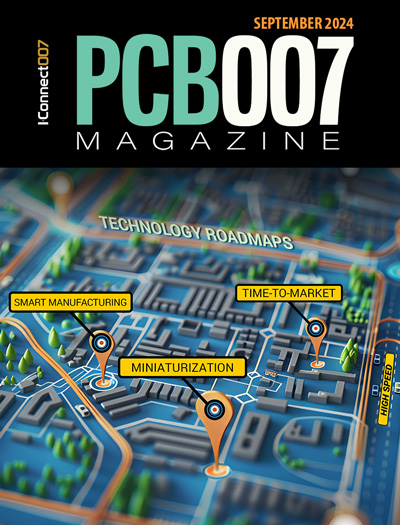-

- News
- Books
Featured Books
- pcb007 Magazine
Latest Issues
Current Issue
Engineering Economics
The real cost to manufacture a PCB encompasses everything that goes into making the product: the materials and other value-added supplies, machine and personnel costs, and most importantly, your quality. A hard look at real costs seems wholly appropriate.

Alternate Metallization Processes
Traditional electroless copper and electroless copper immersion gold have been primary PCB plating methods for decades. But alternative plating metals and processes have been introduced over the past few years as miniaturization and advanced packaging continue to develop.

Technology Roadmaps
In this issue of PCB007 Magazine, we discuss technology roadmaps and what they mean for our businesses, providing context to the all-important question: What is my company’s technology roadmap?
- Articles
- Columns
Search Console
- Links
- Media kit
||| MENU - pcb007 Magazine
Cybord: 100% Component Inspection Is Here
December 21, 2022 | Nolan Johnson, I-Connect007Estimated reading time: 6 minutes
Nolan Johnson speaks with Cybord CEO Zeev Efrat about managing supply chain issues through advanced component verification procedures. Zeev describes the four-step process Cybord recommends to not only ensure that the components used are genuine and in good condition, but also to provide detailed provenance at the component level, thereby improving OEMs' ability to provide cradle-to-grave traceability.
Nolan Johnson: Zeev, Cybord positions itself as a company that can deliver 100% incoming parts verification. Tell me about that.
Zeev Efrat: Right. The common belief is that 100% inspection and verification is not practical because the components are placed on electronic circuits on PCB boards, and there are millions and billions of them, when in fact, yes, it’s doable. We can check all the components that are placed on a PCB, and we can use that to measure for productivity issues that will allow us to make better PCBs—better chips on boards.
We all use the same components, right? In this industry, every new product uses a major chip in the middle—the chip that runs the business on the circuit board. All the preferred chips, however, are the same; they all come from Samsung or wherever services the chip. The problem is normally not with the main chip. The main chips are manufactured by Intel, NVIDIA, etc. We’re talking chip prices that range from $100 to $400 a chip. No, you see the problems with the $10 or $30 chips. Yet today, all the supply chain experts are saying you need to extend your Approved Vendor List and make it as open as possible. Why? Their reasoning is that if you have a shortage here, you can buy there, and you can still affect your product. That’s nice, but then you bring more noise into the system. Cybord enables you to buy from whatever source you can, even if in the past you would never touch them. You want to buy everything now because you want to continue running, although you should still test everything.
Johnson: What does that look like in reality?
Efrat: Because we see all the components, we can identify faulty components and alert the production lines before they are placed on the PCB. The most important thing we provide is traceability, which is based on visuals. Traceability that is surgical to the one board or the one item which is actually faulty. Where that becomes important is when you have a recall, and you have to find and remove those recalled items. Returning 300,000 boards because you don’t know exactly which boards are defective isn’t feasible, especially when only 100 of those 300,000 boards are causing the problem. Because of its visual capabilities, Cybord allows you to identify and easily remove those 100 boards; recalls no longer have to mean returning thousands of electronic boards because of a few faulty ones.
Johnson: Instead, you can recall just the product that’s directly affected. That’s pretty powerful.
Efrat: Yeah, and this system really helps with sustainability overall, because you won’t need to produce as many backup boards just in case something goes wrong.
Johnson: Let’s talk about how Cybord does that. How do you get there?
Efrat: There are four stages in our process. First there’s the Kingfisher, which is a product that helps you check all the components coming in. Maybe they look good but you’re not completely confident in them, so you want to inspect them before they go into production. The Kingfisher machine uses AI algorithms to look at the components from the top and then analyzes them individually so that you don’t need to take them out. You don’t need to inspect anything by statistics; this system allows you to check all the components. If there’s counterfeit evidence, of course, we’re not going to use it. That’s the first stage.
The second stage is the Cybord Aquila at the pick-and-place machine. This machine takes an image of every component from the bottom before it’s placed on a PCB. This is because you need this image to align the component. Normally, this image is deleted after a few milliseconds because we usually don’t need it. It sounds funny, but this machine was specifically developed to retain those images. Now we take that image and analyze it. Same concept: AI models are generated based on very big data—we are talking about 3 billion components currently in our database—and they help us get a good look at the quality of those components. Say, for example, that the quality is high; no cracks anywhere. Is there corrosion of the DFM on this reel? Well, if it’s counterfeit, we don’t even reach the second stage. This machine checks everything, from components, connectors, to anything that we place on the PCB during the SMT process. From those two stages, we now have a record that says everything on this board was checked (Cybord certified).
Now the third stage is the Cybord Osprey at the AOI station. The AOI station looks from the top after the reflow. We check that the markings on those components are okay and genuine, that they’re all from the designated provider per the Approved Vendor List, but say, in this example, that they are not actually compatible with the documentation. Sounds funny, but it happens a lot. When this happens, practically speaking, your traceability isn’t worth anything. Our flow maintains that traceability is accurate.
The fourth stage, which just came out a few weeks ago, is the Cybord Falcon chip Serial Board ID. We are already looking at every component on every board, from top and from bottom. Why not physically label the board immediately? We created this chip, which has a QR on the top and bottom. It’s the size of any capacitor or resistor, and it will be placed during the SMT process. Because it has no electronic value, it can be placed anywhere. It’s plastic. And we are going to read it. So, on the fly, we are labeling every board. You don’t need to put labels. You don’t need to engrave with laser codes; you don’t need to make sure the labels stick. They don’t need to manually manage lists of labels, because all the information we gathered goes up to the cloud and you have a full board record, which includes the label, as well as the analysis of all the components, and means you have a complete record of this board for life.
Johnson: That’s an interesting approach. You’ve touched on how this process works in four different locations in the assembly process. That’s pretty ingenious. What happens when you need to reject something in the later steps?
Efrat: With the information we give you, you know where you don’t have traceability, so you can say, “Hey guys, more than three items are corroded on this reel. Stop this reel. Don’t use this reel anymore.”
Johnson: All this is then feeding back into Factory of the Future and CFX?
Efrat: Exactly. All the Industry 4.0 systems today take information from machines, analyze it, and make it readable. We are actually bringing the line information on the components into CFX, so that if a component is out of tolerance, or if a component is corroded or incorrect, you can see that. Now you can make decisions based on not only what the machine told you, but also on what our database told you, which means you have access to a full knowledge base. If you understood that a batch coming from this company isn’t good for whatever reason—say there’s a lot of faults in it—well, everybody can now use this information. I am not going to tell your company which company provided this information, because every company has its classified log, but if I know that this batch is not good and you are my customer, I will let you know.
Johnson: Is this system available now?
Efrat: This is available now on the line. It’s available now on ASM, Fuji. It will be available on more machines very shortly, probably in about six months or less.
Suggested Items
Indie Semiconductor Extends Automotive Photonics Leadership with Advanced Optical Component Integration Capabilities
11/20/2024 | indie Semiconductorindie Semiconductor, an automotive solutions innovator, has extended its photonics offering with the addition of in-house photonics integration, packaging and system test capabilities.
ASMPT: Highly Flexible Die and Flip-chip Bonder for Co-packaged Optics Production
11/20/2024 | ASMPTThe high-precision AMICRA NANO die and flip-chip bonder has been specially developed for the production of co-packaged optics where which optical and electronic components are integrated in a common housing. With its exceptional process stability and a placement accuracy of ±0.2 μm @ 3 σ, this innovative bonding system is ideally equipped for the communication technology of the future.
Nano Dimension Unveils 3D Printer for Micro Applications at Formnext
11/19/2024 | Nano DimensionNano Dimension, a leading supplier of Additively Manufactured Electronics (AME) and multi-dimensional polymer, metal & ceramic Additive Manufacturing (AM) 3D printing solutions, announces the launch of its Exa 250vx Digital Light Processing (DLP) 3D Printer for micro applications. Developed to enable the creation of superior resolution micro parts at high production throughput, the high-speed Exa was unveiled today for the first time globally at Formnext in Frankfurt, Germany (Hall 11, Stand D22).
IPC Introduces First Standard for In-Mold Electronics
11/18/2024 | IPCIPC announces the release of IPC-8401, Guidelines for In-Mold Electronics. IPC-8401 addresses in-mold electronics (IME) technology, providing industry consensus on guidelines for manufacturing processes, part structures, material selection, and production test methods to integrate printed electronics and components into 3D smart structures.
ZenaTech Participates in Taiwan Trade Mission to Open First Asian Office for ZenaDrone AI Drone Sensor and Component Manufacturing
11/07/2024 | NEWMEDIAWIREZenaTech, Inc., a technology company specializing in AI (Artificial Intelligence) drone solutions and enterprise SaaS (Software-as-a-Service) solutions, announces that company principals are currently participating in a Trade Mission to Taipei, Taiwan as part of an Arizona Commerce Authority (ACA) delegation, with the goal of opening a manufacturing office for its previously announced Spider Vision Sensors Ltd. subsidiary.


